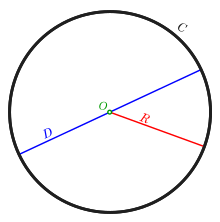
| Geometry | ||||||||||
|---|---|---|---|---|---|---|---|---|---|---|
 Projecting a sphere to a plane Projecting a sphere to a plane | ||||||||||
| Branches | ||||||||||
|
||||||||||
| Zero-dimensional | ||||||||||
| One-dimensional | ||||||||||
Two-dimensional
|
||||||||||
| Three-dimensional | ||||||||||
| Four- / other-dimensional | ||||||||||
| Geometers | ||||||||||
by name
|
||||||||||
by period
|
||||||||||
In geometry, a diameter of a circle is any straight line segment that passes through the centre of the circle and whose endpoints lie on the circle. It can also be defined as the longest chord of the circle. Both definitions are also valid for the diameter of a sphere.
In more modern usage, the length of a diameter is also called the diameter. In this sense one speaks of the diameter rather than a diameter (which refers to the line segment itself), because all diameters of a circle or sphere have the same length, this being twice the radius
The word "diameter" is derived from Ancient Greek: διάμετρος (diametros), "diameter of a circle", from διά (dia), "across, through" and μέτρον (metron), "measure". It is often abbreviated or
Generalizations
See also: Metric space § Diameter of a metric spaceThe definitions given above are only valid for circles and spheres. However, they are special cases of a more general definition that is valid for any kind of -dimensional object, or a set of scattered points. The diameter of a set is the least upper bound of the set of all distances between pairs of points in the subset.
A different and incompatible definition is sometimes used for the diameter of a conic section: any chord which passes through the conic's centre. A diameter of an ellipse is any line passing through the centre of the ellipse. Half of any such diameter may be called a semidiameter, although this term is most often a synonym for the radius of a circle or sphere. The longest diameter is called the major axis. Conjugate diameters are a pair of diameters where one is parallel to a tangent to the ellipse at the endpoint of the other diameter.
The diameter of a circle is exactly twice its radius. However, this is true only for a circle, and only in the Euclidean metric. Jung's theorem provides more general inequalities relating the diameter to the radius.
Symbol
"⌀" redirects here. For other uses, see ⌀ (disambiguation).

The symbol or variable for diameter, ⌀, is sometimes used in technical drawings or specifications as a prefix or suffix for a number (e.g. "⌀ 55 mm"), indicating that it represents diameter. Photographic filter thread sizes are often denoted in this way.
The symbol has a code point in Unicode at U+2300 ⌀ DIAMETER SIGN, in the Miscellaneous Technical set. It should not be confused with several other characters (such as U+00D8 Ø LATIN CAPITAL LETTER O WITH STROKE or U+2205 ∅ EMPTY SET) that resemble it but have unrelated meanings. It has the compose sequence Composedi.
See also
- Caliper, micrometer, tools for measuring diameters
- Conjugate diameters – Perpendicular diameters of a circle or hyperbolic-orthogonal diameters of a hyperbola
- Equivalent diameter – Radius of a circle or sphere equivalent to a non-circular or non-spherical objectPages displaying short descriptions of redirect targets
- Eratosthenes, who calculated the diameter of the Earth around 240 BC.
- Hydraulic diameter – Measure of a channel flow efficiency
- Semidiameter – Straight line segment that passes through the centre of a circlePages displaying short descriptions of redirect targets
- Sauter mean diameter – Average measure of particle size
- Tangent lines to circles – Line which touches a circle at exactly one point
References
- "Diameter—Origin and meaning of diameter by Online Etymology Dictionary". www.etymonline.com.
- Bogomolny, Alexander. "Conjugate Diameters in Ellipse". www.cut-the-knot.org.
- Raphson, Joseph; Ozanam, Jacques (1702). A Mathematical Dictionary. J. Nicholson, and T. Leigh and D. Midwinter. p. 26.
- Puncochar, Daniel E. (1997). Interpretation of Geometric Dimensioning and Tolerancing. Industrial Press Inc. p. 5. ISBN 9780831130725.
- Ciaglia, Joseph (2002). Introduction to Digital Photography. Prentice Hall. p. 9. ISBN 9780130321367.
The filter diameter (in mm) usually follows the symbol ⌀
- Korpela, Jukka K. (2006). Unicode Explained. O'Reilly Media, Inc. p. 171. ISBN 9780596101213.
- Monniaux, David. "UTF-8 (Unicode) compose sequence". Retrieved 2018-07-13.
| Common punctuation and other typographical symbols | |
|---|---|
| |
| |
| |
| |
 of a diameter is also called the diameter. In this sense one speaks of the diameter rather than a diameter (which refers to the line segment itself), because all diameters of a circle or sphere have the same length, this being twice the
of a diameter is also called the diameter. In this sense one speaks of the diameter rather than a diameter (which refers to the line segment itself), because all diameters of a circle or sphere have the same length, this being twice the 

 or
or 
 -dimensional object, or a
-dimensional object, or a